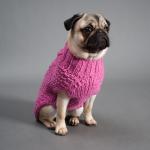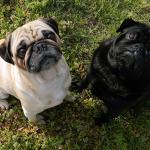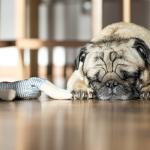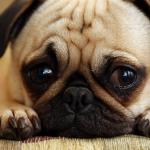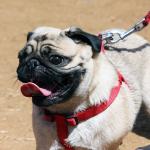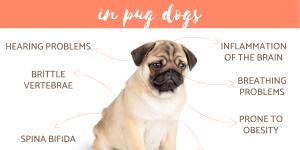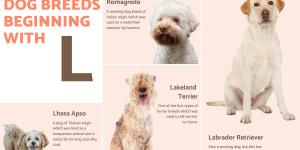Pug
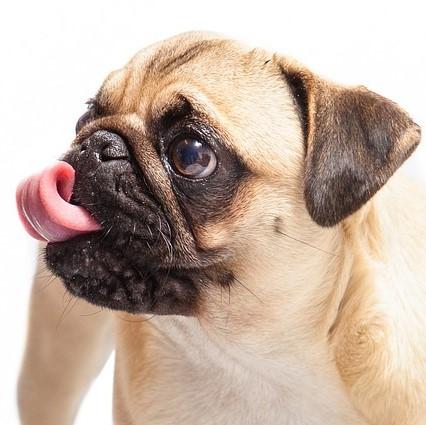
The pug, is a very specific dog. If there was a way to define it in two words we could say it's a bonsai mastiff. The breed's official motto multum in parvo (latin for: a lot in little: a lot of substance for such small space), certainly refers to great dog in a small body.
This breed needs to have company constantly since they are very playful. If they are alone, they can develop separation anxiety. That is why it is not advisable to adopt them if you are a family with very young children, since they may not be given the amount of attention they deserve. But with children a little older, there is no problem with pugs. Quite the opposite, because they are very affectionate and sociable animals. If you have small children we recommend that you read our list of small dogs ideal for children.
In this AnimalWised breed file we will tell you everything you need to know about pugs.
- Asia
- China
- Group IX
- 5-14
- 14-18
- 18-22
- 22-27
- 27-31
- More than 31
- 2-7
- 7-22
- 22-55
- 55-100
- 100-220
- 8-10
- 10-12
- 12-14
- 15-20
- Low
- Meidum
- High
Origin of the pug
As like many other dog breeds, the origin of the pug is uncertain and controversial. It is known that they come from China, but it is still debated whether their relatives are closer to large molosoid dogs or the pekingese and similar dogs. What is known is that centuries ago these dogs were, along with the Pekingese, the favorite animals in the Tibetan monasteries. They have probablybeen brought to Holland by Dutch merchants, from whom the race would have spread to France, England and all of Europe.
Since their arrival in Europe and later in America, the pug has been considered a charming companion dog and dignified exhibition dog. Western fascination with this breed has reached the point where many pugs have been protagonists of films and television series.
Physical characteristics
The pug is a short, plump and compact dog. Despite being a small dog, the pug is a muscular animal. The upper line of their body is level and their chest is broad. Their head is large, round and without clefts in the skull. They have no apple shape, as in Chihuahuas, and their skin is very wrinkled. Their snout is short and square. The pug's eyes are dark, large and globular. They are bright and their expression is sweet and worried. The ears are thin and small, with a velvety texture. They canbe presentedin two varieties:
- Pink ears, which are small, hanging and folded back.
- Button ears, which are ears folded forward, pointing toward the eye.
The tail is of high insertion and presents itself coiled, as tight as possible, on the hip. According to the International Cynological Federation (FCI) standard, double-tapering is highly desirable. The ideal size of the pug is not indicated in the standard FCI of the breed, but these dogs are small and their height at the withers is usually Between 25 and 28 centimeters. The ideal weight, which is indicated in the standard of the race, ranges from 6.3 to 8.1 kilograms.
This dog's hair is thin, smooth, soft, short and shiny. Its colors vary between silver, apricot, light fawn and black. The snout, the moles on the cheeks, the rhombus of the forehead and the stria (a line from the occiput to the twisting of the tail) should be black.
Personality
The pug has the typical temperament of a companion dog. They are affectionate, cheerful and playful. They have a strong personality and like to draw attention, but they have a stable character.
These dogs are easy to socialize and, properly socialized, tend to get along with adults, children, other dogs and other animals. However, while they are playful, they do not withstand the intense play and mischief of young children. Of course, to get along with strangers and other pets, it is important to socialize them from puppies.
In general, these dogs do not present behavioral problems, but they may develop separation anxiety with some ease. Pugs need constant companionship and can become destructive dogs when left alone for a long time. They also need to exercise and receive mental stimulation so they do not get bored.
They are excellent pets for most people and families with large children, and even for novice homeowners. However, this breed is not advisable for families with very young children, as they often unintentionally mistreat small dogs. Nor are they good pets for people who spend most of the day away from home or for very active people.
Caring for a pug
The care of a pug's coat does not require much time or effort, but it is necessary to brush them once or twice a week to remove the dead hair. These dogs lose a lot of hair, so it may be a good idea to brush them more often to keep furniture and clothing free of dog hair. Bathing should only be done when the dog is dirty, but wrinkles on the face and muzzle should be wiped with a damp cloth and dry frequently to avoid skin infections.
Pugs are very playful dogs, and need moderate exercise, with daily walks and moderate play time. Care must be taken not to inflict them with very intense exercises, since their flattened snout and sturdy structure do not provide them with much resistance and make them susceptible to thermal shocks, especially in hot and humid climates.
On the other hand, these dogs need a lot of company and are not suitable for people who spend most of their time away from home. The pug demand constant companionship and attention and can develop destructive habits when they are left alone for a long time. They are dogs to live indoors with the family and adapt very well to the life in departments and in big cities.
Training
These breed of dogs are easy to train when using positive training styles. It is common to hear traditional trainers say that pug dogs are stubborn dogs and difficult to train, but that is often the result of a poor choice of the method of dog training, rather than a characteristic of the breed. When positive training methods such as clicker training are used successfully, excellent results can be achieved with these dogs.
Health
Despite being a small dog, the pug tends to be healthy, excluding potential problems caused by its short snout. The breed does not present canine diseases with exaggerated incidences, but it frequently presents elongated palate, stenotic nostrils, patellar dislocation, Legg-Calve-Perthes disease and entropion. Cases of epilepsy also occasionally occur.
Because of their prominent eyes and flattened face, they are prone to eye injuries. Also, due to their robust structure, they tend to develop obesity, so you have to take care of their diet and amount of exercise daily.
Pug photos

